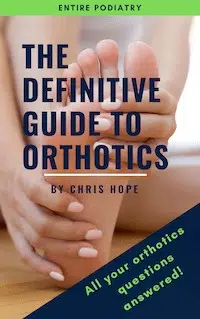Plantar Fasciitis and Orthotics
Foot orthotics are special innersoles designed by your podiatrist. They are worn inside your shoe to support, correct, and control the movement of your feet. They are designed to fit your feet more efficiently than over-the-counter arch supports. At Entire Podiatry we offer a range of different type of orthotics to suit different needs.
How do orthotics help treat plantar fasciitis?
Investing in a pair of orthotics is one of the most effective methods of reducing your plantar fasciitis pain. Orthotics are a customised foot innersole/arch support which reduces strain through the plantar fascia ligament to facilitate healing. Orthotics are also cushioned and spread the pressure out evenly across your foot.
As part of the orthotic process the podiatrist will perform a thorough ‘biomechanical assessment’. This involves the podiatrist performing a thorough assessment of your gait/walking pattern, the way that pressure is carried through your feet as well as the way that your joints move. This assessment will reveal potential causes of your plantar fasciitis and the orthotics will be designed in such a way to correct this. E.g. plantar fasciitis is often present in those who over-pronate. If this is identified as a concern for you, a custom orthotic would reduce the amount that your foot ‘rolls in’ in order to reduce the strain off the ligament.
Do orthotics work for plantar fasciitis?
In our clinical experience, custom foot orthotics will generally provide the most effective symptom relief due to their ability to closely hug the arches of your feet to lift and support the injured ligament. Orthotics will likely be one part of your treatment plan, and it will be important that they are worn in conjunction with your other treatments e.g. exercises, footwear and activity modification.
What shoes fit orthotics for plantar fasciitis?
Finding the correct shoe which will accommodate and compliment the orthotics will be an important discussion to be had with you and your podiatrist. Some orthotics are not suited to certain shoe types and the orthotics prescribed by your podiatrist will also vary depending on the style of shoe you intend to wear your orthotics with.
The good news is that gone are the days where orthotics could only be worn in big clunky shoes. Nowadays there are many styles of shoes which are able to fit orthotics, e.g. men and women’s work shoes, football boots, sandals with removable footbeds, casual weekend shoes, cycling cleats and even snowboard boots!
When designing the orthotics its important to consider what activities cause your plantar fasciitis to worsen and what type of shoes you are normally wearing when you experience symptoms. For example, if you notice heel pain mostly when you are at the gym, it will be best to fit orthotics for your gym shoes.
Plantar fasciitis and strapping
Having your foot strapped with sports tape can be a very effective way to reduce plantar fasciitis pain and encourage healing.
The podiatrist is able to strap your foot to reduce strain through the plantar fascia ligament. It is not uncommon for us to see people limping into the clinic room and walking out after being correctly strapped for plantar fasciitis. Plantar fasciitis strapping provides immediate pain relief and also holds the ligament in an immobilised position to encourage healing.
The podiatrist is able to demonstrate how to perform this strapping technique so you can perform it yourself at home.
Plantar fasciitis night braces
Some people receive benefit from the use of a night splint. This splint is worn whilst sleeping and holds the foot in a stretched position with the goal of restricting the contraction that occurs over night and lengthening both the Achilles tendon and the plantar fascia. This can be particularly helpful for those who suffer from pain in the first few steps after waking. Entire Podiatry supplies night splints. Contact us for more information.
Plantar fasciitis massage/exercises
As part of your treatment plan, your podiatrist will develop a specific exercise program for you involving some simple stretches or strengthening activities for your foot. These exercises will assist with pain relief, encourage healing and also reduce the possibility of recurrence of your plantar fasciitis. If muscle tightness is deemed to be a contributing cause of your plantar fasciitis, it can very likely to return if this muscular tightness is not addressed.
Is a foot massage good for plantar fasciitis?
We often get asked if massage is good for plantar fasciitis. In short, yes! Stretching out the plantar fascia is a very good way to warm up the ligament and make it better able to tolerate load.
Much of that terrible ‘first steps in the morning pain’ can be reduced with simple stretching or ‘massage’ of the ligament. Whenever we are off our feet the plantar fascia contracts and shortens and the body tries to ‘repair’ itself. The first time you stand up in the morning the ligament is abruptly ‘awakened’ and stretched past it’s limits. Not only is this causing more damage, it is a horrible pain. By taking some time to ‘warm up’ your foot after periods of inactivity, the plantar fascia is able to better tolerate the force of your body weight through your feet and the risk of damage is reduced.
 This self-massage can be as simple as rolling the bottom of your foot over a round object e.g. a can or a ball.
This self-massage can be as simple as rolling the bottom of your foot over a round object e.g. a can or a ball.
It is important that your podiatrist assess your foot thoroughly to advise if this treatment is correct for you – there are certain conditions that also cause arch pain which may be made worse by this self-massage. This is why a clear diagnosis must be sought first.
Plantar fasciitis treatment massage therapy for calves
Your calf muscles and your Achilles tendon function very closely with your plantar fascia. If muscular tightness is contributing to the development of your plantar fasciitis your podiatrist can advise on some stretches and strengthening exercises to assist with this.
Our podiatrists are also able to perform soft tissue releases, similar to a deep tissue massage on problems areas and trigger points specifically calves.
Plantar fasciitis and Compression socks
Compression socks, also known as plantar fasciitis socks can be helpful in the treatment of plantar fasciitis. These are a tightly fitted sock, which keep the foot stable and reduce the ligament stretching and pulling. Compression socks achieve a similar goal to strapping tape but have the benefit of being able to be worn comfortably while you sleep or under regular socks without leaving sticky residue from traditional taping.
Do compression socks help plantar fasciitis at night?
Some people note considerable relief in their ‘first-step pain’ when wearing the compression sock overnight. The compression sock helps with the inflammatory nature of plantar fasciitis. With plantar fasciitis there is a build-up of inflammatory products, especially overnight. These inflammatory products help repair the damaged ligament, but also causes increased pressure around the foot and nerves which contributes to the intense pain for the first few steps in the morning.
Wearing this compression sock overnight can reduce the excessive build-up of inflammatory products, which can reduce the pain felt in the morning.
Gel heel pads for plantar fasciitis
Some people benefit from the use of a gel heel pad worn over the innersole of your shoe. This can provide cushioning and pain-relief to the heel. This is more effective if your plantar fasciitis is affecting your heel rather than your arch. It is important to not that whilst the heel pad can make the heel feel better when walking, it does not assist in correcting the mechanics of your feet or reducing strain through the ligament.
Where to buy compression socks for plantar fasciitis
At Entire Podiatry we sell compression socks.




